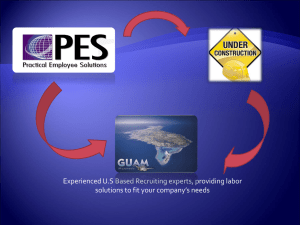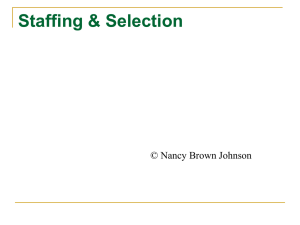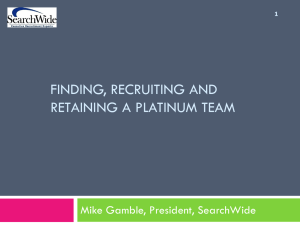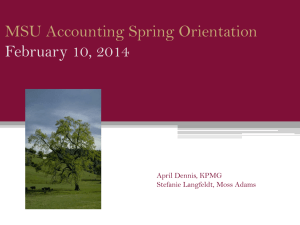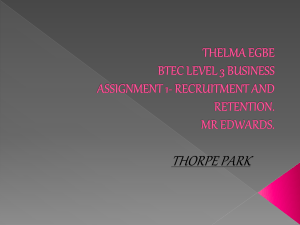Chapter 6 Recruiting and labor markets
advertisement
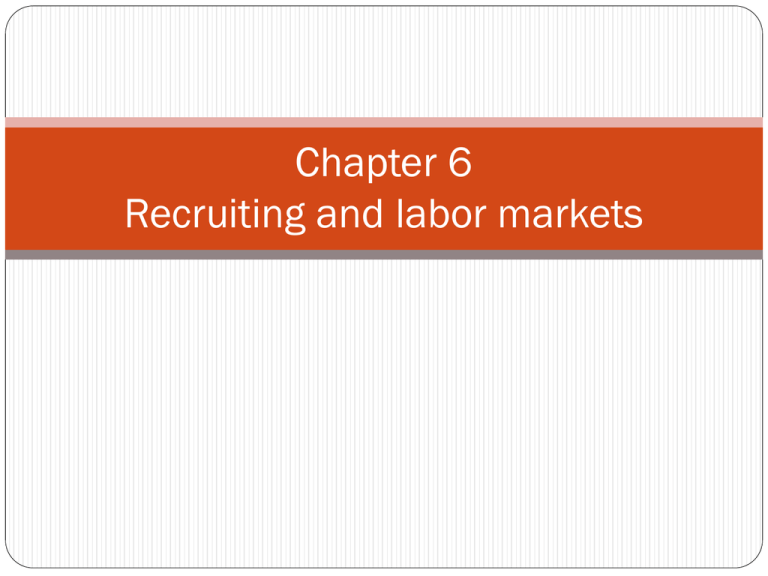
Chapter 6 Recruiting and labor markets Recruiting is the process of generating a pool of qualified applicants for organizational jobs Cost of unfilled jobs Quality of workforce may cost more Be strategic when recruiting: know the industry, know your competitors, CULTIVATE RELATIONSHIPS, promote THE COMPANY BRAND Train your recruiters and managers: don’t violate EEO rules Labor market: external pool from which employers attract employees Labor market components: Labor force population: all individuals who are available for selection if all possible recruitment strategies are used Applicant population: a subset of the labor force population that is available for selection using a particular recruiting approach Applicant pool: all persons who are actually evaluated for selection. Use an Applicant tracking system Individuals selected Note: unemployment rates and applicant population Considerations for determining applicant populations # and type of recruits needed Timing of recruiting to ensure timely placement External and internal messages on job details Qualifications of competent applicants to be considered Sources for obtaining qualified applicants Outside and inside recruiting means to be used Administrative recruiting and application review activities Different labor markets and recruiting Industry and occupational labor markets: careers: nurses, home health care, post secondary teachers, truckers and welders Educational and technical labor markets: military, medical, informational technology (IT) Geographic labor markets: local, area or regional, national, or international Global labor markets: overseas jobs and laws Strategic recruiting decisions Recruiting presence and image: continuous efforts to recruit, keeps employer in labor market and intensive recruiting when needed (Midland) Employment branding and image: the view held by both employees and outsiders Organization based versus outsourced recruiting Recruitment process outsourcing (RPO): add to number of candidates and reduce recruiting costs Professional employer organizations (PEO) and employee leasing: employees are hired and leased to a company Regular versus flexible staffing: temporaries, independent contractors, reducing cost of insurance, vacation, and benefits pay Recruiting and EEO: diversity considerations EEO and recruiting efforts: non biased and work to hire underrepresented protected class members Recruiting diversity: race, ethnicity, older, single parents, disabilities, welfare to work, homeless Job previews: advantages, demands, expectations, and challenges of job Recruiting source choices: internal vs. external Internet recruiting E recruiting: internet job boards, professional/career websites, employer websites Social networking sites Blogs E video Twitter Legal concerns: demographics of applicants, confidentiality, privacy…. Advantages: saves time and money Disadvantages: more resumes, less access by lower socioeconomic applicants Legal issues in Internet recruiting Are rejections really based on the qualifications needed for the job? How can data about an individual’s protected characteristics be collected and analyzed for reports? Are too many people being excluded on the basis of unlawful information? Do they really want the job, just because they accessed a job board? How does Internet recruiting relate to confidentiality and privacy Advantages: may save money, add to the pool, save time Disadvantages: more work because more applicants, more emails to deal with Companies getting away from job boards and here goes: LinkedIn and Twitter! Employment agencies Headhunters: employment agencies that focus their efforts on executive, managerial and professional positions (1) contingency firms charge a fee to employer after person is hired (2) retainer firms charge a client a set fee whether or not the contracted search is successful. External recruiting sources Media: newspapers, magazines, TV, radio, billboards Job fairs and creative recruiting: SHRM chapter, virtual job fairs, drive through job fairs Educational institutions and recruiting Desirable capabilities of college recruits: GPA, leadership potential, communication skills, professional motivation Recruiting for high school and technical schools Internal recruiting methods Internal recruiting databases and internet related sources Internal candidates: you know more about them, no real recruiting costs… Job posting system in which the employer provides notices of job opening and employees respond by applying for specific openings: how long should an employee stay in a job before applying for another one, should they tell their current boss, what if no one applies that qualifies? Employee focused recruiting Current employee referrals Rerecruiting of former employees and applicants: former employees Recruiting evaluation and metrics Quantity and quality Time to fill openings Costs per recruiting method Recruitment satisfaction analyses Process metrics yield ratios selection rates: comparison of the number of applicants at one stage of the recruiting process with the number at the next stage AND acceptance rate: percent of applicants hired divided by total number of applicants offered jobs Success base rates: compare the number of past applicants who have become successful employees against the number of applicants they competed against for their jobs. Increasing recruiting effectiveness Resume mining: software approach Applicant tracking: from job listing to performance appraisal tracking Employer career website: Internal mobility: tracks internal candidates Realistic job previews: preview of employer and jobs Responsive recruitment: applicants get timely responses
